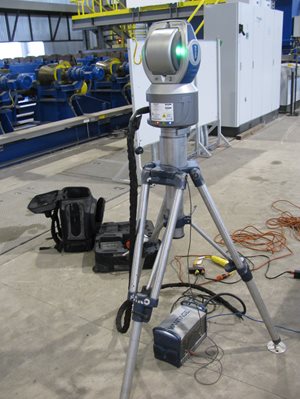Overview
We currently operate up to 10 fully-equipped field crews utilizing the latest surveying technology plus a complete inside support staff. We will work closely with you to identify your survey requirements and will be on-site when you need us, for as long as you need us. Our crews have the capabilities to complete traditional land surveying assignments as well as construction layout and staking, and we also have specialists on staff for Vertical Construction Surveying as well as 3D Laser Scanning & Tracking.
Vertical Construction Surveying
 Our vertical construction surveying services include establishing theoretical column lines on completed floors in addition to establishing benchmarks for the use of various subcontractors. Maintaining accurate theoretical column line positions from floor to floor is critical due to the multitude of uses in which this control is utilized. Interior partition walls utilize this control and may contain vertical conduits inside the walls that have very little position tolerance from floor to floor.
Our vertical construction surveying services include establishing theoretical column lines on completed floors in addition to establishing benchmarks for the use of various subcontractors. Maintaining accurate theoretical column line positions from floor to floor is critical due to the multitude of uses in which this control is utilized. Interior partition walls utilize this control and may contain vertical conduits inside the walls that have very little position tolerance from floor to floor.
Exterior building facades, such as window mullions and glass panels, are placed using our control. Ensuring the window units are installed in the correct position and plumb ensures the exterior façade will not contain shadow lines and is pleasing to the human eye.
We strive to maintain a very tight tolerance in setting vertical construction. This is achieved by erecting many reflective prisms on surrounding buildings. By daily checking of these prisms prior to setting any control, we can adjust as needed for building movement due to warming by the sun.
3D Laser Scanning & Tracking
 In 2016, R.E. Warner acquired industrial surveying firm Accurate Technologies, creating our Precision Measurements & Mapping group. These specialists use advanced technologies for documentation, measurement and mapping that are not common to most engineering and surveying firms. The high-tech tools provide more data and better accuracy and are also more time- and cost-efficient.
In 2016, R.E. Warner acquired industrial surveying firm Accurate Technologies, creating our Precision Measurements & Mapping group. These specialists use advanced technologies for documentation, measurement and mapping that are not common to most engineering and surveying firms. The high-tech tools provide more data and better accuracy and are also more time- and cost-efficient.
- 3D Laser Tracking provides large volume field measurements with the highest precision in 3D. The tracker sends a laser beam to a reflective target on an object being measured; the returning beam delivers 3D coordinate data. Software is then used to fit this data to geometrical entities.
- 3D Laser Scanning generates fast and exact measurements of the real world in 3D with time savings and greater accuracy. The technology also provides non-contact data capture, including color, with accuracy of +/- 2mm. The scanner emits a laser that captures millions of data points in minutes, creating a dense point cloud that is used to create a 3D CAD model.
- Aerial Photography & 3D Mapping - Unmanned aerial vehicles (drones) can provide high-resolution aerial photography and elevation data collection (3D maps). Aerial photography can be generated with 4 cm pixel images. This dense photography captures small objects that are not visible in most publicly available aerial imagery. The small pixel size also picks up field-located markings as small as 3-4 inches, such as utility locators’ markings, utility reference posts, environmental engineers’ field markings, etc.
Control markers set by field surveyors have a geographic accuracy of ~8 cm within the photography – also exceeding most aerial photography available on the Internet. This data can be geo-referenced for use in GIS systems and CAD drawings, and can be set to state plane or project coordinates. The images can also be brought into AutoCAD and used for accurate background data.
The aerial contour (3D) mapping system captures elevation data accurate to 6 cm with proper ground control, allowing our staff to create elevation contours with an accuracy down to 0.2 feet for mapping, volumetric surveys, and more.